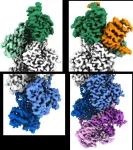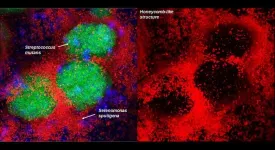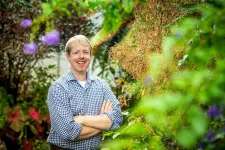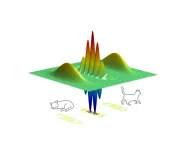(Press-News.org) Each year, about 200,000 people in the United States are diagnosed with a bulge in the lower part of the aorta, the main artery in the body, called an abdominal aortic aneurysm (AAA).
New research from the University of Cincinnati examines the role a particular metabolite plays in the development of AAA and could lead to the first treatment of the condition.
The research was published in the journal Circulation.
“We started the study by examining whether AAA patients themselves had an increase in trimethylamine N-oxide (TMAO). We examined an American and Swedish cohort with 354 human samples, and we compared those AAA patients to 1,775 control subjects,” says Phillip Owens, PhD, co-first author of the study along with Tyler Benson, PhD, both of the Division of Cardiovascular Health and Disease in the UC College of Medicine. “We started going into animal models after that, looking at what happens when we feed a high choline diet which leads to higher production of TMAO.”
Choline, found in a variety of foods with the richest sources being meat, fish, poultry, dairy and eggs, is processed into the organic compound TMAO when meat is digested by the bacteria in the gut.
The research found that in humans, TMAO levels were increased in AAA patients, but that doesn’t mean it is causing the disease state, according to Owens. To see if TMAO had an actual effect, researchers tried to replicate it in an animal model to manipulate the levels of TMAO and then block those in the subject to see whether TMAO increases were exacerbating the disease.
“We found that a high choline diet produces increased levels of AAA, and increased aneurysm rupture as well,” says Owens. “When we take that same model and inhibit the levels of TMAO using gut microbial inhibitors, inhibiting the conversion of the choline to the trimethylamine to the TMAO, we were able to reduce the levels of choline-induced AAA. It was in fact not the choline, but the choline-induced TMAO that led to an increase in aneurysm.”
Owens says the research came about as the result of interest expressed in the topic by former UC College of Medicine student Kelsey Conrad, PhD, who is a co-first author on the paper.
“It’s always one of my goals to try to get a project that interests the student, not just have them do something in my lab that I need to get done,” says Owens. “We created this project for that student then we filed a grant and found the funds. It’s not usually the way it goes.”
Conrad says she’s grateful to have worked with a mentor in Owens who supported her growth in a way that considered her past experiences and aligned with her professional goals.
“The potential for this work to radically change clinical care and improve patient outcomes in AAA is very exciting,” says Conrad who is now a faculty member at Smith College in Massachusetts. “Selectively targeting the gut microbes to prevent the progression of disease for this population would be a novel therapy for these patients who currently lack any pharmacological treatment options.”
There are an estimated 1 million men and women with AAAs in the United States and Owens says when you extrapolate that to the world population of 7 billion, that means potentially 20 to 30 million people worldwide have an AAA.
“We’ve gotten it to work in animal models which doesn’t necessarily mean it’s going to work in humans,” says Owens. “I think if the data has shown us one thing, it’s that TMAO is markedly increased in several cardiovascular diseases and if you inhibit it, at least in animal models, you do impact inflammation and overall mortality. Where I’m excited is if these inhibitors do make it to market, it’s potentially something in our arsenal that we can have for AAA where right now we have nothing.”
That may be a possibility sooner than later, Owens adds. Stanley Hazen at the Cleveland Clinic and co-author on the study, developed the drug fluoromethyl choline used in the studies and is constantly working on refining these inhibitors, which are currently being evaluated for their efficacy to inhibit TMAO in humans.
END
University of Cincinnati study examines role of metabolites in disease treatment
Findings could result in first-of-its-kind treatments for an aortic aneurysm
2023-06-08
ELSE PRESS RELEASES FROM THIS DATE:
Study unravels the mysteries of actin filament polarity
2023-06-08
Actin filaments — protein structures critical to living movement from single cells to animals — have long been known to have polarity associated with their physical characteristics, with growing “barbed” and shrinking “pointed” ends. The ends of the filament are also different in the way they interact with other proteins in cells. However, the mechanism that determines these differences has never been entirely clear to scientists. Now, researchers from the Perelman School of Medicine at the University of Pennsylvania have revealed key atomic structures of ...
Colorful foods improve athletes’ vision
2023-06-08
Nutrition is an important part of any top athlete’s training program. And now, a new study by researchers from the University of Georgia proposes that supplementing the diet of athletes with colorful fruits and vegetables could improve their visual range.
The paper, which was published in Exercise and Sport Sciences Reviews, examines how a group of plant compounds that build up in the retina, known as macular pigments, work to improve eye health and functional vision.
Previous studies done by UGA researchers Billy R. Hammond and ...
Research puts lens on a new vision for land use decision making
2023-06-08
A new framework for making better and more transparent decisions about the use of our land could help to balance society’s demands upon it with protecting and enhancing the environment.
Researchers led by the University of Leicester have proposed a framework for decisions on land use, from nationwide policymaking to building happening at street level, that would involve the most representative range of stakeholders, from those with financial interests in the land to the local communities who use it and more besides.
Now published in the journal People and Nature, it encourages decisionmakers ...
'Most horrible’ brain tumor patients falling through healthcare cracks, study shows
2023-06-08
Patients suffering from the “most horrible” rare brain tumour are falling through the cracks of mental health provision, University of Essex researchers have found.
A recent study which interviewed patients and clinicians discovered survivors struggle to access therapy available for other serious illnesses, such as cancer, and there was a lack of specialised support.
For the first time, the mental health of British rare brain tumour patients was examined by psychologists and now researchers are calling for urgent changes to the health service.
Dr Katie Daughters hopes her findings –published in ...
Discovering cell identity: $6 million NIH grant funds new Penn Medicine research to uncover cardiac cell development
2023-06-08
PHILADELPHIA— Historically, scientists have studied how cells develop and give rise to specialized cells, such as heart, liver, or skin cells, by examining specific proteins. However, it remains unclear how many of these proteins influence the activity of hundreds of genes at the same time to turn one cell type into another cell type. For example, as the heart develops, stem cells and other specialized cells will give rise to heart muscle cells, endothelial cells (lining of blood vessels), smooth muscle cells, and cardiac fibroblasts. But the details of this process remain mysterious.
As a result of a $6 million, seven-year ...
Penn Dental Medicine collaboration identifies new bacterial species involved in tooth decay
2023-06-08
Philadelphia — Collaborating researchers from the University of Pennsylvania School of Dental Medicine and the Adams School of Dentistry and Gillings School of Global Public Health at the University of North Carolina have discovered that a bacterial species called Selenomonas sputigena can have a major role in causing tooth decay.
Scientists have long considered another bacterial species, the plaque-forming, acid-making Streptococcus mutans, as the principal cause of tooth decay—also known as dental caries. However, in the study, which appeared 22 May in Nature Communications, the Penn Dental Medicine and UNC researchers showed that S. sputigena, previously associated ...
Team finds reliable predictor of plant species persistence, coexistence
2023-06-08
CHAMPAIGN, Ill. — Like many ecological scientists, University of Illinois Urbana-Champaign plant biology professor James O’Dwyer has spent much of his career searching for ways to measure and predict how specific plant communities will fare over time. Which species in a diverse population will persist and coexist? Which will decline? What factors might contribute to continuing biodiversity?
In a new study reported in the journal Nature, O’Dwyer and his colleague, U. of I. graduate student Kenneth Jops, report the development of a method for determining ...
Scientific Symposium - Improving pediatric cancer care by scientific excellence - Princess Máxima Center for pediatric oncology - Utrecht, the Netherlands
2023-06-08
The Princess Máxima Center's Board of Directors, Research management and the clinical directors warmly invite you to attend our interdisciplinary symposium, to celebrate the first five years existence of the Princess Máxima Center for Pediatric Oncology.
This 2-day Scientific Symposium will take place on June 12th and 13th 2023 in the Jaarbeurs in Utrecht. There will be presentations from well-known speakers covering the various disciplines within the field of pediatric oncology and beyond, showcasing latest developments and technologies.
This event will create ...
Connecting the dots: Leveraging information to improve the nation’s public health
2023-06-08
INDIANAPOLIS – The pandemic has placed a spotlight on public health -- its workforce, infrastructure and underlying information systems designed to collect, analyze and manage public health data.
Informatics, health information technology and public health experts from across the nation convened at an American College of Medical Informatics symposium concluded that how information is received and shared by public health agencies is overdue for “a strategically designed, technology-enabled, information infrastructure for delivering day-to-day essential public health services and to respond effectively to ...
Schrödinger’s cat makes better qubits
2023-06-08
Quantum computing uses the principles of quantum mechanics to encode and elaborate data, meaning that it could one day solve computational problems that are intractable with current computers. While the latter work with bits, which represent either a 0 or a 1, quantum computers use quantum bits, or qubits – the fundamental units of quantum information.
“With applications ranging from drug discovery to optimization and simulations of complex biological systems and materials, quantum computing has the potential to reshape vast areas of science, industry, and society,” says ...
LAST 30 PRESS RELEASES:
Making lighter work of calculating fluid and heat flow
Normalizing blood sugar can halve heart attack risk
Lowering blood sugar cuts heart attack risk in people with prediabetes
Study links genetic variants to risk of blinding eye disease in premature infants
Non-opioid ‘pain sponge’ therapy halts cartilage degeneration and relieves chronic pain
AI can pick up cultural values by mimicking how kids learn
China’s ecological redlines offer fast track to 30 x 30 global conservation goal
Invisible indoor threats: emerging household contaminants and their growing risks to human health
Adding antibody treatment to chemo boosts outcomes for children with rare cancer
Germline pathogenic variants among women without a history of breast cancer
Tanning beds triple melanoma risk, potentially causing broad DNA damage
Unique bond identified as key to viral infection speed
Indoor tanning makes youthful skin much older on a genetic level
Mouse model sheds new light on the causes and potential solutions to human GI problems linked to muscular dystrophy
The Journal of Nuclear Medicine ahead-of-print tip sheet: December 12, 2025
Smarter tools for peering into the microscopic world
Applications open for funding to conduct research in the Kinsey Institute archives
Global measure underestimates the severity of food insecurity
Child survivors of critical illness are missing out on timely follow up care
Risk-based vs annual breast cancer screening / the WISDOM randomized clinical trial
University of Toronto launches Electric Vehicle Innovation Ontario to accelerate advanced EV technologies and build Canada’s innovation advantage
Early relapse predicts poor outcomes in aggressive blood cancer
American College of Lifestyle Medicine applauds two CMS models aligned with lifestyle medicine practice and reimbursement
Clinical trial finds cannabis use not a barrier to quitting nicotine vaping
Supplemental nutrition assistance program policies and food insecurity
Switching immune cells to “night mode” could limit damage after a heart attack, study suggests
URI-based Global RIghts Project report spotlights continued troubling trends in worldwide inhumane treatment
Neutrophils are less aggressive at night, explaining why nighttime heart attacks cause less damage than daytime events
Menopausal hormone therapy may not pose breast cancer risk for women with BRCA mutations
Mobile health tool may improve quality of life for adolescent and young adult breast cancer survivors
[Press-News.org] University of Cincinnati study examines role of metabolites in disease treatmentFindings could result in first-of-its-kind treatments for an aortic aneurysm




